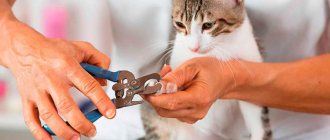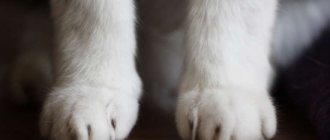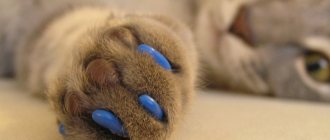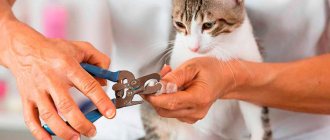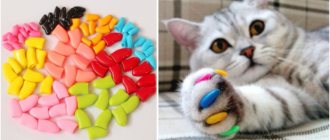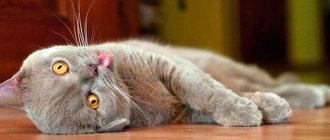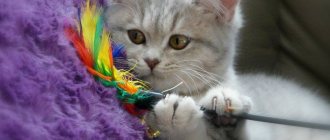It often happens that without accustoming a cat to a scratching post, owners complain about damaged furniture and wallpaper, and over time they come to the conclusion that they are ready to take radical measures. Declawing and so-called “soft paws” are not only an unpleasant procedure for a cat, but also quite dangerous. Let's find out why.
In order to understand the essence of the problem, you first need to understand that all cats, without exception, sharpen their claws. This is inherent in them by nature. Cats need to grind down the keratinized membranes of their claws in order to free themselves from the old ones and allow new ones to grow.
Another reason that underlies this ancient instinct is a kind of marking of territory. On the pet's front paws there are glands with which the cat applies a special secretion to the scratched object. Where the cat feels good and comfortable, she will happily sharpen her claws.
And of course, this is a great way for your pet to stretch and relax, and stretch his muscles after sleep.
General information
Onychectomy is not just “cutting the cat’s claws forever”, it is more like amputating the phalanges of the paws.
There are several options for performing the operation:
- Surgical declawing of a cat using a scalpel and scissors under general or local anesthesia.
- Modern method of declawing using laser.
- Separation of connections between tendons and claws. As a result, the cat’s claws will not grow, or, on the contrary, they will grow too quickly, which happens extremely rarely.
Upon completion of the operation, the animal is injected with painkillers and sent home.
TIP: The best age at which the paws will heal as quickly as possible is considered to be up to 1 year, but not less than 8-9 months. At a younger age, they are not yet fully formed, but after that, the nails are already harder.
Why does a cat tear up furniture and wallpaper?
A cat's claws grow continuously, like human nails. Only you and I can take scissors or go for a manicure. Animals have it more difficult. Therefore, in order for a cat to stop spoiling the interior that is dear to the heart and wallet, you need to figure out why she does this.
Zoologists have identified 3 main reasons for scratching surfaces:
- A cat scratches surfaces when it wants to shorten its claws;
- Scratching is a way of marking territory: the cat secretes gland secretions from the pads of its paws. Only cats feel the smell; humans are insensitive to the secretion;
- Scratching helps the animal to remain calm and feel comfortable in its territory.
We have already written that after surgery, many cats stop using the litter box. This is due to the fact that they need to mark their territory. If previously an animal could claim its rights with the help of a secretion in its paws, the smell of which people cannot smell, after onychectomy they do not have this opportunity. But the instinct remains.
The cat begins to mark as best it can. For the owner, it looks like the pet is shitting anywhere.
Advantages and disadvantages of declawing cats
It doesn't take long to remove a cat's claws. But are there any advantages from this? Yes, I have. This is the impossibility of damaging furniture and the absence of scratches on the skin of household members.
But the disadvantages include a number of points:
- anesthesia is not just a dream, but stress for the body;
- the animal is in great pain for a very long time after the operation. The pain is dulled with various painkillers, which is also considered an intervention in the body;
- the phalanx may grow back and require repeated surgery;
- This is real stress for a cat, which not every animal experiences without consequences.
- a cat without claws is defenseless, and any trip outside can end in disaster;
- as a result of onychectomy and a feeling of vulnerability, the pet may use its teeth;
- the pet’s character changes, it may become withdrawn;
- Difficulties with the toilet: sometimes cats refuse to go to the litter box due to the inability to rake;
- the animal will never step on the entire foot completely again in its life, which affects its gait.
Therefore, maybe it’s worth thinking about other options for protecting furniture from cat scratches?
Legality
Cosmetic veterinary surgery is popular in the United States - animals have ligaments cut, piercings, and implants inserted. But even in their historical homeland, the “Soft Paws” procedure is abandoned due to the negative impact on health and quality of life. Declawing without indication has already been banned in 12 states.
In European countries, onychectomy without medical indications has long been prohibited; it is considered intentional mutilation. This is not a subjective attitude, but a legal definition of the essence of the process. A complete ban applies in the following countries:
- Great Britain
- Netherlands
- Germany
- Denmark
- Sweden
- Finland
- Norway
- Australia
- Israel
- Brazil
- Portugal
- Czech
- Serbia
- Belgium
- France
- Italy
- Spain
- Ireland
In Russia, a project to ban euthanasia, cupping and onychectomy without indications is under development. It will complement the already adopted Responsible Animal Welfare Act. Many breeders stipulate a ban on the removal of phalanges in the sales contract, but it is difficult to track its implementation. About a third of Russian clinics do not provide this service.
Purpose of Cat Declawing Procedure
In most cases, owners decide to remove cat claws because the animal begins to damage interior items. Agree, not everyone can accept the loss of their favorite leather sofa, beautiful wallpaper and other expensive things.
Another reason, and it is more significant, may be aggression towards other animals, children and household members. But is it worth resorting to such radical methods of solving the problem? You need to start from the very basics. You should first try to raise your cat using primitive methods. For example, punish for damaged property, using various ways to show that such behavior is unacceptable.
If you couldn’t come to an agreement with your cat, then you should try to purchase special care items, such as a scratching post. Don’t forget that scratching posts are also different and before you give up, you should try several of their options, because not every one may suit your furry beauty’s taste.
Among other things, it is better to accustom your animal to trimming its nails from a very young age. This manipulation should be carried out approximately every 3-4 weeks, this can also protect your property from damage.
If none of the above methods helped you, then you can use a device called “anti-scratch.” These are caps that are put on the claws and attached with special glue. They do not last forever and require periodic replacement as needed.
How to make your cat's claws safe?
Sometimes trimming cats' claws is necessary to protect other pets, children, wallpaper and furniture from scratches and damage. But even this procedure cannot completely protect the animal’s environment from its weapons extending from its paws. But there is salvation.
The first option is to use cat claw caps.
They are put on “hooks”, thereby making the cat safe. After all, even properly trimmed claws can cause harm. And after wearing such silicone things, you can completely forget for a couple of months about damage to surrounding objects. The only downside is that claw covers for cats are not cheap. However, you make the claws not only soft for surrounding objects, but also bright. After all, silicone claws for cats can come in a wide variety of colors. Imagine your pet having a colorful and unusual, harmless manicure.
This way to protect yourself and your interior is suitable not only for fashionistas, but also for pregnant cats.
After all, expectant mothers should not experience stress. And trimming cats' claws is almost always a real challenge. She has to be held tightly by one person while another manicures the cat. Imagine what a test this is for a pregnant pet. If you use too much force when fixing, you can harm the kittens, even cause miscarriage. And by wearing claw covers, you can ensure a calm pregnancy for your pet and life for yourself. Neither the furniture, nor the wallpaper, nor you will suffer from your scratch.
A more difficult option is to completely remove cats' claws. This operation is performed by a veterinarian in a clinic under general anesthesia only as a last resort. For example, if an injury was sustained as a result of which the claw was torn out of the finger. This happens when owners forget to shorten their pet’s overgrown claws in a timely manner.
Knowing how to trim a cat's claws, there should be no need for such an operation. Just remember to check your animal's toes every 2 weeks.
What is soft paw surgery?
Onychectomy is a surgical procedure to remove a pet's claws. Popularly, the procedure has the pleasant name “soft paws”, but in fact it is a serious test for the cat. During the manipulation, the veterinarian removes not only the transparent plate with a sharp end, but also the entire claw phalanx (part of the finger). The operation is performed in a clinic under general anesthesia.
Any surgical intervention in one way or another affects the physical and psychological state of the animal. Unlike most surgical procedures, the soft paw procedure is often performed only at the whim of the owner and is not aimed at saving the life and health of the animal.
Pet owners can choose more humane ways to deal with the problem of sharp nails. Among them:
Cat claw covers
- painless trimming of nails twice a month using a special nail clipper;
- purchasing silicone stickers;
- buying a scratching post.
Indications for surgery
There are no absolute indications for “velvet paws” surgery. An owner who agrees to get rid of his pet’s sharp claws once and for all must understand the seriousness and danger of this procedure.
Relative indications for surgical intervention of this kind can be considered:
- exceptionally aggressive nature of a pet that cannot be trained;
- unsuccessful attempts to train an adult pet to sharpen its claws in a specially designated area;
- regular attacks on small children living in the same house with a cat;
- fungal disease of the claw plate in an advanced stage, which is difficult to treat;
- seizures of epilepsy (claws are removed so that during an attack the animal does not injure itself or a person);
- abnormal ingrowth of claws into the fingertips, deformation of the claw phalanx.
Contraindications to amputation of claws
It is strictly forbidden to perform the “velvet paws” operation on cats leading an outdoor lifestyle. Without claws, the animal becomes defenseless and will not be able to climb a tree or protect itself from attacks by stray dogs.
It is highly undesirable to perform onychectomy on cats living on the upper floors. It is known that they love to walk on the balcony and hunt for birds. Without claws, a cat is defenseless; it will not be able to catch on to the railing when falling from a height.
Also, any surgical interventions are contraindicated in cats who are allergic to anesthesia. The consequences of an allergic reaction can be serious, including death.
Alternative Methods
Using anti-scratch paws
Anti-scratch - the simplest and most reliable method.
One of the alternative methods is the use of anti-scratch. These are special silicone caps made of soft plastic material. They have a number of advantages. The cat gets the opportunity to freely release and sharpen its claws, because it retains the instinctive need for this even with anti-scratch protection. But the pet will not harm clothes or furniture. Also, the cat will not be able to scratch the owner. This nuance is especially relevant if there are small children in the house.
The caps do not cause any discomfort to the animal. A cat can lead a full life and not change its habits. Anti-scratch products will not cause harm to health, even if the pet swallows them. Special medical glue is used to fix it on the claw. On sale you can find anti-scratch caps of various sizes, which will allow you to choose caps for both an adult and a kitten.
Anti-scratch guards are put on as follows:
- First, the cat needs to be picked up and stroked so that it does not worry when its paws are manipulated.
- Apply a small amount of glue inside the cap, lightly press on the foot pad so that the claws come out, and put on the anti-scratch guards.
- Press down on both sides and hold for 1-2 minutes. This will help keep the cap firmly in place. Apply anti-scratch guards to the remaining claws in the same way.
It is recommended to start using caps when the kitten is six months old. Previously this was not necessary. A small kitten's claws are very soft, so he won't be able to cause any harm with them. Older cats, who no longer feel the need for the point of their claws as they become fragile, also do not need anti-scratch guards.
Nail trimming
Nail trimming is an equally practical alternative.
Another alternative method is trimming the nails. The procedure is carried out once every 10 days using special tweezers. Each claw is trimmed to 1 mm. Do not exceed this level, otherwise you may damage the sensitive area. This will cause pain and bleeding in the cat. Place the tweezers perpendicular to the claw. After trimming, praise your cat so that she develops a positive attitude towards the procedure. It is better to accustom an animal to pruning from childhood.
How is the operation soft paws for cats performed?
If you have made a conscious decision to have a soft paw surgical procedure, it is important to find a good veterinarian who will competently and skillfully perform this operation. It is usually performed under general anesthesia. No one “rips out” the claws, the doctor carefully removes them using special tools, the pillows are not injured, sutures are placed on the incisions, it is better if they are absorbable. The paws are bandaged to protect them from bleeding. Additional medications may be prescribed to help the cat recover better from anesthesia.
But my cat scratches
In many countries, onychectomy is prohibited. In Russia, a ban on cutting off part of a cat's paw has not yet been introduced. But humane veterinary doctors in the Russian Federation do not carry out the procedure, since there are no direct indications. Finding good specialists who will perform the “soft paws” operation in St. Petersburg is almost impossible.
Scratching isn't the only problem. It is worth remembering that a cat not only scratches, but also bites. A bite is much more painful than a scratch. Therefore, the owners will not be able to completely rid themselves of injuries.
So what makes us bring our pet to the clinic? Is this really a necessity or more of a false security imposed by society? Let's try to determine the root cause of the problem to understand whether it is possible to do without surgery.
Description of declawing surgery
Onychectomy is banned in a number of European countries.
Local anesthesia is sometimes used for the operation, but general anesthesia is more often used.
The claws are removed entirely from the first phalanx of the finger. A suture and anesthetic ointment are applied to the damaged area. Then the paw is bandaged, and a collar is put on the cat’s neck, which will protect the seams from licking.
Along with the application of anesthetic ointment, auxiliary injections are administered.
Post-operative cat care
Usually after 6-10 hours the cat can already move independently. It is recommended to keep an eye on her for at least a day or two until she completely recovers from anesthesia; this time is individual for each animal. Veterinarians recommend providing the animal with a comfortable bed on the floor, limiting walking and jumping in the first hours after surgery, and not allowing jumping from a height.
A day or two after the operation, the paws may bleed, and the cat will feel uncomfortable stepping on them, but within 10-12 days everything should return to normal, and the cat will continue to run, play and jump on cabinets.
The structure of cats' paws
Cats are the only family of mammals that walk on pads, without relying on their claws . Yes, sometimes animals run with their claws out, but there must be a good reason for such behavior.
For comparison, canines, rodents, and mustelids step on their paws with their entire weight, and their claws rest on the ground for a stronger “grip.” Simply put, compared to other animals, cats walk on their toes.
The next important nuance is the way the claw grows. It doesn't hurt to cut your nails as long as your finger isn't directly affected. The fact is that a person’s nail grows on top of the finger and is devoid of nerve endings. In a cat, like in many other animals, claws are an extension of the fingers . The claws of animals have a sinus with blood and nerve endings. If you read the scientific description of the structure of a cat's fingers and the knee joints of people, the former will be more complicated.
Unlike other animals, a cat's claws are connected to the fingers by a complex plexus of tendons. In the very section that is responsible for releasing and hiding the claws, there are not only tendons, but also soft joints, muscles, and with them, bundles of very sensitive nerve endings. If this mechanism were not so complex, cats would not have become the most honored hunters. If you compare a dog and a cat, only the second can straighten and pick up its fingers at will. Different dogs may have different toe shapes, but no dog can retract (hide) its claw.
Cat claws are often compared to the phalanges of human fingers, but this analogy is incorrect. The phalanx of the finger does not bend at our request and does not hide when we are not using it.
The complex mechanism of connecting a cat's claws and fingers is directly involved in walking, running, maneuvering, maintaining balance, etc.
In almost any movement, tailed animals use their fingers, which straighten or tuck when necessary.
Rehabilitation of cats after onychectomy
When the cat's claws are removed, the process of recovery after surgery begins, both for the condition of the paws and for the entire body. Fluffy needs the caring attitude of the owner.
There are a number of nuances for caring for a cat:
- pain relief in the form of injections, if necessary;
- daily treatment of wounds;
- the dressing needs to be changed regularly;
- A visit to the doctor is recommended once a week.
The cat is really looking forward to its owner's love and care, only in this case it will get better sooner.
The recovery period after surgery lasts a month. During the first few days it is painful for the cat to stand on its paws; it will be hampered by pain and discomfort. Then the walking process gradually improves, but the cat may limp.
It is better to remove the cat's claws first on the front paws and then on the back paws. One by one deletion is allowed. This requires expert advice.
Possible complications
There are many negative effects after an operation called “soft paws”. The experience and professionalism of the veterinarian plays a big role - violation of the surgical technology entails a risk of infection. Also, if the soft tissues do not heal properly, the cat may experience discomfort when walking, resulting in changes in the animal’s gait and posture.
Consequences of declawing a cat
The results are the most disappointing. Interfering with the structural integrity of a cat’s body, in fact, makes the cat disabled.
In this case, the torment begins the moment the patient wakes up from anesthesia. The poor things are not feeling well. Requires careful care. Nausea and vomiting, increased body temperature and rapid heartbeat are observed. If you are allergic to the components of anesthesia, the outcome can be fatal.
The recovery period lasts at least a month and is complicated by severe pain.
Wounds require daily thorough treatment (washing, applying healing agents, changing the bandage). To avoid tearing off the bandages and injuring the paws, a protective collar is put on the patient, which causes a lot of inconvenience to the already unfortunate creature.
Regardless of the type of anesthesia, the animal experiences severe pain after surgery.
The first days after the operation the animal refuses to eat and does not move. After 5-8 days he takes his first steps, causing physical suffering. The vestibular apparatus undergoes dramatic changes, including when distributing the load. Purr is learning to walk again.
Consequences and complications
Let's look at the complications caused by merciless surgery:
- pathologies of the musculoskeletal system (impaired coordination of movement, falling on paws, changes in gait);
- joint damage (arthritis) caused by load changes;
- purulent infections of bone tissue (osteomyelitis);
- curvature of the spine caused by newly acquired defects (the operated pet steps on the entire foot when walking and running, a healthy individual only on the toes);
- muscle atrophy.
At the same time, the following disease processes are observed:
- bleeding from the wound surface;
- decreased resistance to diseases;
- deformation of nerve endings, in which every step, even after external wound healing, causes pain;
- development of urolithiasis;
- ingrown claw (the stratum corneum remaining after poor-quality treatment grows inward, causing inflammation);
- blood poisoning;
- injuries received by a crippled creature as a result of loss of its former balance;
- dysbiosis and other changes in the digestive organs caused by the consumption of antibiotics necessary for the speedy healing of wounds.
At the same time, onychectomy traumatizes the psyche.
Declawing causes damage to a large number of nerve endings
The pet becomes fearful, aggressive and withdrawn. Instead of claws, she uses her teeth, including without reason (when a person tries to approach her).
Some specimens stop relieving themselves on the tray because they cannot rake up the litter in order to bury excrement. Social life becomes more complicated. Warriors become vulnerable on the street. They may die from the teeth of relatives or dogs.
Relationships with the opposite sex worsen. Love games lose their charm due to the impossibility of giving a slap in the face, which is characteristic of this process.
Amputation leaves an indelible mark on a kitten. Experienced fear, pain and inconvenience make the baby angry, unsociable and antisocial.
Unfortunately, there are currently many supporters of cruel surgery. It seems to them that the procedure will not harm their beloved kitty.
Since ancient times, pulling out people's nails has been equated to torture. This is worth thinking about!
Pros
The Soft Paws procedure does not benefit cats; declawing only benefits owners. Without the main weapon, the ability to mark territory by tearing wallpaper, flooring, and furniture is lost. The claws do not cling to clothes, do not accidentally dig into the legs or shoulder when you take the cat in your arms or sit on your knees.
Removal of the phalanges is resorted to before the birth of a child or shortly after the birth of the baby. Parents are worried that the pet will cause injury to the newborn. Onychectomy is considered when children perceive a pet as a toy - this is easier than a long explanation of why you can’t pull a cat’s whiskers.
The advantage of declawing is the prevention of many diseases - herpes, toxoplasmosis, chlamydia, fungal infections. This is on par with the myth of warts after contact with a toad. If you delve into the topic, the absurdity is obvious. But many believe unconditionally, ignoring scientific arguments.
For example, cat scratch fever is a Bartonella infection. The bacteria are found in the saliva, urine, tear fluid and other secretions of the carrier cat. For a person to get sick, he must have low immunity. But a scratch is not necessary - bacteria still enter the bloodstream through microcracks in the skin.
Alternative to Declawing
There are options in which the risk to your pet’s health is minimized.
Trimming
Murka is fixed so as not to damage the limbs. If necessary, bring in an assistant. Using forceps with rounded ends, carefully cut off the overgrown stratum corneum (no more than one millimeter). The use of scissors is not recommended. Manipulations are fraught with cuts. The structure of the plate is damaged.
Using special stickers
The best way. Non-toxic glue developed by veterinarians is applied to the claws, onto which silicone stickers of the appropriate shape are fixed. Harmless, available in different colors.
The stickers are effective for a month. Good for long-term use.
Gluing silicone caps to the cat's claws
Recovery after surgery
To avoid any infection, your pet will have to be carefully monitored for a week, or maybe more.
Systematic monitoring by a veterinarian will be required. Painkiller injections may also be required.
It is imperative to treat your pet’s stitches, make dressings and make sure that the pet does not chew the bandages or lick the stitches.
Principles of caring for Oriental cats- How to brush a cat's teeth - step-by-step instructions on how to clean a cat's fangs and teeth at home (110 photos)
Shampoo for cats - tips on choosing a manufacturer, how to accustom a cat to water treatments and features of bathing cats (video + 120 photos)
